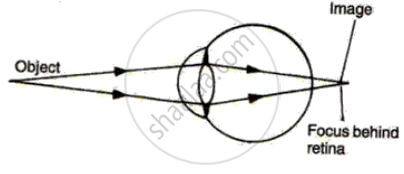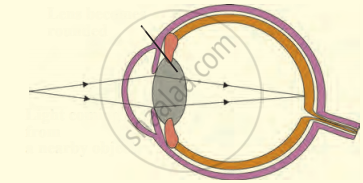Advertisements
Advertisements
Questions
Name the capacity of the eye lens to change its focal length as per need.
Write the name.
The ability of lens to adjust the focal length as per need is:
Solution
The capacity of the eye lens to change its focal length as per need is called accommodation.
RELATED QUESTIONS
Differentiate between: Rods and cones
The size of the pupil becomes ______ when you see in dim light.
Explain the mechanism of vision.
Match the following:
| Column I | Column II |
| (i) Myopia | (a) Converging power of eye lens becomes low |
| (ii) Hypermetropia | (b) Converging power of eye lens remains the same |
| (c) Converging power of eye lens becomes high |
Where is the image formed in a human eye?
Name two types of cells in the retina of an eye which respond to light.
What is the range of vision of a normal human eye?
Fill in the following blank with suitable words:
When light is dim, the pupil becomes................
Fill in the following blank with suitable word:
The iris controls the amount of................entering the eye.
How is the amount of light entering the eye controlled?
How does the convex eye-lens differ from the ordinary convex lens made of glass?
List, in order, the parts of the eye through which light passes to reach the retina.
Describe the working of the human eye with the help of the above diagram.
Which of the following changes occur when you walk out of bright sunshine into a poorly lit room?
(a) the pupil becomes larger
(b) the lens becomes thicker
(c) the ciliary muscle relaxes
(d) the pupil becomes smaller
Suggest how your irises help to protect the retinas of your eyes from damage by bright light.
After testing the eyes of a child, the optician has prescribed the following lenses for his spectacles:
Left eye : + 2.00 D
Right eye : + 2.25 D
The child is suffering from the defect of vision called:
(a) short-sightedness
(b) long-sightedness
(c) cataract
(d) presbyopia
Differentiate between members of the following pair with reference to what is asked in bracket.
Rod and cone cells (pigment contained)
Mention if the following statement is true (T) or false (F) Give reason.
Sometimes medicines dropped into the eyes come into the nose and even throat
Name the following:
Short sightedness.
The diagram alongside represents a certain defect of vision of the human eye.
(i) Name the defect.
(ii) Describe briefly the condition in the eye responsible for the defect.
(iii) Redraw the figure by adding a suitable lens correcting the defect. Label the parts through which light-rays pass.
(iv) What special advantage do human beings derive in having both eyes facing forward?

Name the following:
The part of the eye responsible for change in the size of the pupil.
State the Location:
Iris
State the Function:
Choroid coat in the eye
Write scientific reason.
The movie cannot be enjoyed if seat of a viewer is too close to the screen in the cinema.
The following figure show the change in the shape of the lens while seeing distant and nearby objects. Complete the figures by correctly labelling the diagram.

Write the function of the human eye and label parts of the figure given below.

A person cannot see distinctly objects kept beyond 2 m. This defect can be corrected by using a lens of power
Name the part of the eye which gives colour to the eyes.
Write down the names of parts of the eye in the blank spaces shown in the figure.

Which one of the following statements is NOT correct?
Which cells of the retina enable us to see coloured objects around us?
Match the following:
| Column - I | Column - II |
| 1. Retina | a) Path way of light |
| 2. Pupil | b) Far point comes closer |
| 3. Ciliary muscles | c) near point moves away |
| 4. Myopia | d) Screen of the eye |
| 5. Hypermetropia | e) Power of accommodation |
Match the following:
| Column - I | Column - II |
| 1. Retina | a. Path way of light |
| 2. Pupil | b. Far point comes closer |
| 3. Ciliary muscles | c. near point moves away |
| 4. Myopia | d. Screen of the eye |
| 5. Hypermetropia | e. Power of accommodation |
Name the following:
Capacity of the eye to focus at different distances.
Where is the following located?
Yellow spot
Name the following:
Two pigments of the sensory cells.
Give reason:
Blind spot is considered as 'area of no vision'.
